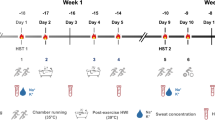Summary
Climatic chamber experiments were carried out with male subjects who were submitted to various rapid temperature changes. All experiments were performed first with the subjects at rest and later at work on a bicycle ergometer. The aims of the study were 1) to obtain quantitative data enabling to determine effects of a) abrupt thermal load, b) abrupt work load, and c) combined load on the topography and the dynamics of temperatures and effectors, and 2) to answer the question whether the effects of combined load may be computed by a linear superposition of pure thermal plus pure work load.
Skin temperatures generally respond more directly to abrupt changes of thermal than of work load. This is in contrast to the dynamic behaviour of central temperatures which moreover exhibit the interesting effect of a transient paradoxical respone both to the onset of work and of thermal load.
Time constants of the dynamics of metabolic heat production are high in response to changes of thermal load as compared to the time constants at the onset and end of worl. Generally the time constants of skin temperatures are shorter at rest than at work. Temperature topography changes only to a small extent in exercising subjects.
The central temperature increase to combined thermal and work load is not significantly different from the added amount of temperature increases due to pure thermal and to pure work load. This suggests a quasi-linear superposition of both thermal effects and confirms, in accordance with further evidence of this and former studies, the hypothesis that work load does not interfere non-linearly with the regulatory processes. However, an input from thermosensitive elements in the muscles should be assumed.
Similar content being viewed by others
References
ÄikÄs E, Karvonen MJ, Piironen P, Ruosteenoja R (1961) Intramuscular, rectal, and oesophageal temperature during exercise. Acta Physiol Scand 54: 366–370
Chappuis P, Pittet P, Jequier E (1976) Heat storage regulation in exercise during thermal transients. J Appl Physiol 40: 384–392
Hardy JD, DuBois EF (1937) The technique of measuring radiation and convection. J Nutr 15: 461–475
Graener R, Werner J (1980) Development of a microprocessor system for biomedical data acquisition. In: Kaiser WA, Proebster WE (eds) From electronics to microelectronics. North-Holland Publishing Company, Amsterdam, pp 543–545
Jessen C, Feistkorn G, Nagel A (1983) Temperature sensitivity of skeletal muscle in the conscious goat. J Appl Physiol 54: 880–886
Kitzing J, Kutta D, Bleichert A (1968) Temperaturregulation bei langdauernder körperlicher Arbeit. Pflügers Arch 30: 241–253
Kitzing J, Behling K, Bleichen A, Scarperi M, Scarperi S (1972) Antriebe und effektorische Ma\nahmen der Thermoregulation bei Ruhe und wÄhrend körperlicher Arbeit. Int Z Angew Physiol 30: 119–131
Libert JP, Candas V, Vogt JJ (1978) Sweating response in man during transient rises of air temperature. J Appl Physiol 44: 284–290
Nadel ER (1983) Review: Factors affecting the regulation of body temperature during exercise. J Therm Biol 8: 165–169
Nadel ER, Bullard RW, Stolwijk JAJ (1971a) Importance of skin temperature in the regulation of sweating. J Appl Physiol 31: 80–87
Nadel ER, Mitchel JW, Saltin B, Stolwijk JAJ (1971b) Peripheral modifications to the central drive for sweating. J Appl Physiol 31: 828–833
Nielsen B (1981) Exercise and temperature regulation. In: Szelenyi Z, Szekely M (eds) Contributions to thermal physiology. Pergamon Press, Oxford, pp 537–544
Nielsen B (1976) Metabolic reactions to changes in core and skin temperature in man. Acta Physiol Scand 97: 129–138
Nielsen M (1938) Die Regulation der Körpertemperatur bei Muskelarbeit. Skand Arch Physiol 79: 193–230
Snellen JW (1972) Set point and exercise. In: Bligh J, Moore RE (eds) Essays on temperature regulation. North-Holland, Amsterdam, pp 139–148
Tarn H-S, Darling RC, Cheh H-J, Downey JA (1978) Sweating response: a means of evaluating the set-point theory during exercise. J Appl Physiol 45: 451–458
Wenzel H-G (1968) über die Beziehungen zwischen Körperkerntemperatur und Pulsfrequenz des Menschen bei körperlicher Arbeit unter warmen Klimabedingungen. Int Z Angew Physiol 26: 43–94
Wenzel H-G, Piekarski C (1982) Klima und Arbeit. Bayer. Staatsmin f Arbeit und Soz Ordn München
Werner J (1981) Control aspects of human temperature regulation. Automatica 17: 351–362
Werner J (1983) Influences of rate of temperature change on effector mechanism in human thermoregulation. J Therm Biol 8: 51–54
Werner J (1984) Die Regelung der menschlichen Körpertemperatur. W de Gruyter, Berlin
Werner J, Reents T (1980) A contribution to the topography of temperature regulation in man. Eur J Appl Physiol 45: 87–94
Author information
Authors and Affiliations
Additional information
Supported by the Deutsche Forschungsgemeinschaft, SFB 114
Rights and permissions
About this article
Cite this article
Werner, J., Heising, M., Rautenberg, W. et al. Dynamics and topography of human temperature regulation in response to thermal and work load. Europ. J. Appl. Physiol. 53, 353–358 (1985). https://doi.org/10.1007/BF00422853
Accepted:
Issue Date:
DOI: https://doi.org/10.1007/BF00422853




